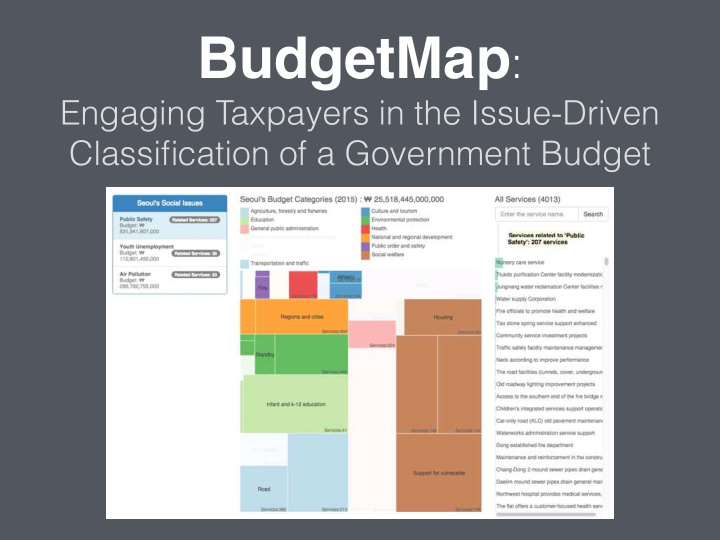



BudgetMap : Engaging Taxpayers in the Issue-Driven Classification of a Government Budget
BudgetMap : Engaging Taxpayers in the Issue-Driven Classification of a Government Budget Nam Wook Kim Harvard Eun-Young Ko Songyi Han Jonghyuk Jung KAIST KAIST KAIST Changwon Lee Juho Kim Jihee Kim KAIST KAIST Stanford & KAIST
Sewol Ferry Disaster Apr 16, 2014 , 294 out of 476 people died
325 of the passengers were secondary school students on a field trip.
Public safety Citizens became suspicious about where the government spends their taxes .
Difficult to explore government programs for a particular issue Source: US Office of Management and Budget, 2016
Programs related to the issue are spread out across various budget categories Source: US Office of Management and Budget, 2016
“The traditional budget classification system is mainly designed for administrative efficiency .” — A former congressman
Open Government Simply opening up more budget information to the public may not be sufficient .
Supporting the navigation of a government budget through social issues
Supporting the navigation of a government budget through social issues A social problem or conflict raised by a society. from Wikipedia
Supporting the navigation of a government budget through social issues • Use the language of the public • Reflect timely public interests
Challenge How can we classify budget data using social issues ?
Challenge How can we classify budget data using social Issues ? • Huge amount of budget data • Constantly changing social issues
Challenge How can we classify budget data using social Issues ? • Huge amount of budget data • Constantly changing social issues Unsustainable for a government to handle this problem every time a new issue arises.
Challenge How can we classify budget data using social Issues ? • Huge amount of budget data • Constantly changing social issues Automated solution may not be able to understand nuances in social issues .
Citizensourcing + Tagging To turn to taxpayers to classify budget programs with social issues .
BudgetMap Solicits taxpayers to identify issue-budget tags and facilitates visual exploration of the tagged budget data
Budget Data from the City of Seoul Budget spending and Budget categories for 4013 programs in 2015
Budget Data Model Program is a unit of operating budget for a set of services.
Budget Data Model Social Issue is a form of tag that may connect to multiple programs.
Budget Data Model N -to- N relationship Social Budget Issue Program
Budget Data Model N -to- N relationship Social Budget Issue Program Tag Types “Related” “Unrelated” “Unclear”
Implementation BudgetMap Tagging Interface
Implementation BudgetMap Tagging Interface Explore randomly selected budget programs and the list goes on
Implementation Majority Voting Program Issue Public Safety Special Rescue Team Operation
Implementation Majority Voting Program Issue Public Safety Special Rescue Team Operation Related if ‘ Related ’ Tags ‘ Unrelated ’ Tags > + Threshold ( x ) e.g., x=3 5 people 10 people
Implementation BudgetMap Visualization Automatically Translated
Implementation BudgetMap Visualization Social Issues
Implementation BudgetMap Visualization Budget Categories
Implementation BudgetMap Visualization Budget Programs for the current category
Implementation BudgetMap Visualization Selected Issue: Air Pollution
Implementation BudgetMap Visualization Budget programs related to Air Pollution
Implementation BudgetMap Visualization Span multiple budget categories Transportation Health Environment …
Evaluation Tagging results and perception changes after tagging tasks
Evaluation: Procedure Pre-task Tagging Post-task Survey Task Survey
Evaluation: Procedure Pre-task Tagging Post-task Survey Task Survey + Interviews with budget experts
Evaluation: Procedure Pre-task Tagging Post-task Survey Task Survey + Interviews with budget experts Paid for participation
Evaluation: Procedure Pre-task Tagging Post-task Survey Task Survey Informedness & perspective on the city’s budget.
Evaluation: Procedure Pre-task Tagging Post-task Survey Task Survey Changes in informedness & perspective on the city’s budget.
Evaluation: Procedure Pre-task Tagging Post-task Survey Task Survey Tagging budget programs with: 1) public safety , 2) air pollution , and 3) youth unemployment .
Evaluation: Tag Results 104 citizens participated through online communities & social media, generated 730 tags per participant.
Evaluation: Tag Results 104 citizens participated through online communities & social media, generated 730 tags per participant. Compared with a reference solution constructed by 3 budget experts
Evaluation: Tag Results Evaluated by varying the threshold (x) in the majority voting formula: ’Related’ Tags > ‘Unrelated’ Tags + threshold (x) accuracy(%) threshold(x)
Evaluation: Tag Results 84% (x=3) of the issue-budget tags were correctly matched to the reference solution .
Evaluation: Tag Results Coverage of Participants’ Tags threshold(x=3) Public Safety: 7% ( 843 tags) Air Pollution: 14% ( 1685 tags) Youth Unemployment: 33% ( 3973 tags) Out of Total Possible Tags 3 issues x 4,013 programs = 12,039 tags
Evaluation: Summary People are capable of contributing expert-quality tags
Evaluation: Survey Results Participants’ level of informedness significantly improved after tagging tasks “I know in which budget programs Seoul’s tax revenues are spent.”
Evaluation: Survey Results Their perspective on government spending marginally improved , remaining on the negative side. “The city government is executing its budget in the right direction regarding public safety.”
Evaluation: Summary People gain informational benefits from doing tagging tasks.
Lessons
Confirmed the Feasibility of Issue-Driven Approach
“We encounter social issues in our daily lives . They made it easier for me to evaluate the suitability of budget programs.” — p045
“Understanding government budget spending through issues would be effective in solving social problems .” — p026
“The issue-driven approach would be more intuitive to the general public .” — Officer in the Seoul government
More importantly, By looking into the differences among tags
No ground truth for issue-program tags
Individuals have different perspectives
Dealing with opinionated crowds calls for a different kind of quality control.
Important to incorporate diverse, contextual, and localized viewpoints
Limitations & Future Work Allow people to create new issues & Live deployment & Data spanning multiple years
BudgetMap is a step toward participatory democracy Leverage open Build systems for Improve awareness government data civic engagement on budgetary issues
Make Government Great Again!
budgetwiser.org Thank you namwkim@seas.harvard.edu
Recommend
More recommend